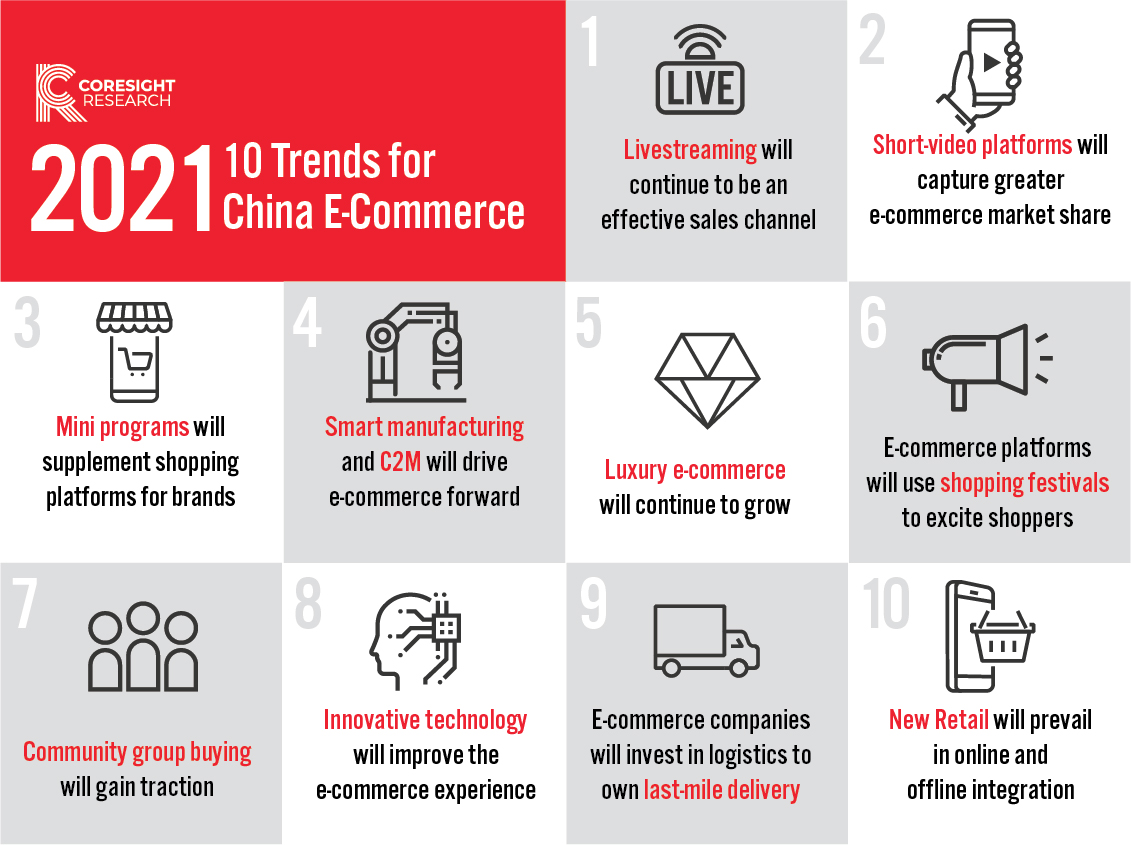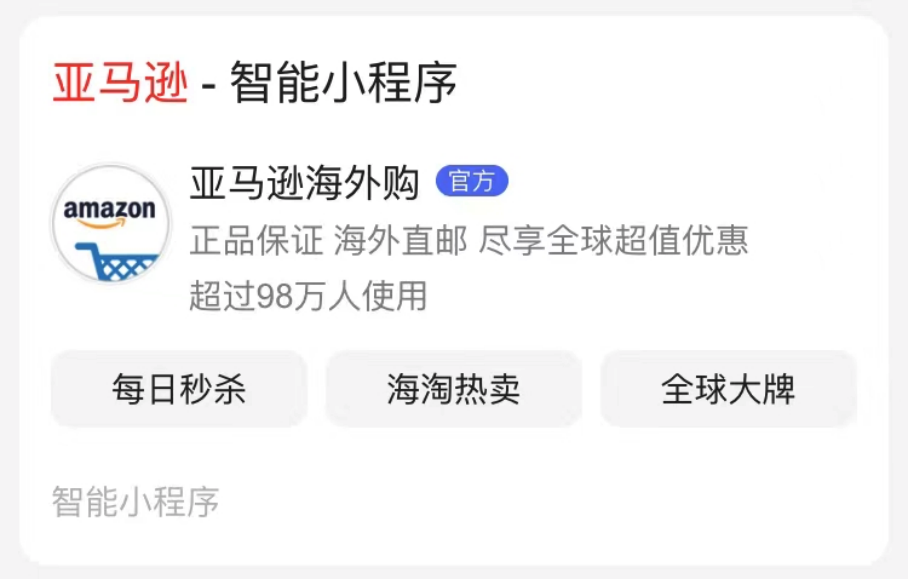
Nitheesh NH
What’s the Story?
In this report, we outline 10 key trends for Chinese e-commerce in 2021 and discuss how brands and retailers that are targeting the China market could capitalize on the changes we expect to see over the course of the year.Why It Matters
E-commerce in China saw strong performance during the Covid-19 crisis in the country, which pushed more brands and retailers online. The market sustained solid growth following the crisis, and we saw impressive sales results during major shopping festivals such as Singles’ Day in November 2020:- Alibaba recorded ¥498.2 billion ($74.1 billion) in GMV for Singles’ Day 2020—the official sales period for which was November 1–11—representing an increase of 26% from the same period in 2019, according to the company.
- JD.com recorded $40.9 billion in GMV during November 1–11 this year, representing a 34.6% year-over-year increase.
10 E-Commerce Trends in 2021: A Deep Dive
[caption id="attachment_121595" align="aligncenter" width="700"] Source: Coresight Research[/caption]
1. Livestreaming Will Continue To Be an Effective Sales Channel
We expect livestreaming to become a valuable marketing tool for more brands following the coronavirus pandemic, helping their businesses to become more agile and resilient. The livestreaming e-commerce market in China will total ¥2 trillion ($305 billion) in 2021, representing 384% growth from 2019, according to KPMG and Alibaba’s research unit AliResearch (an estimate made after the Covid-19 outbreak).
Furthermore, we expect more merchants to host their own livestreaming sessions, rather than working with KOLs (key opinion leaders). Around 60% of transactions on Alibaba’s Taobao Live platform came from merchants’ self-run livestreaming sessions during the quarter ended June 2020, according to Alibaba. There are a few advantages to this strategy:
Source: Coresight Research[/caption]
1. Livestreaming Will Continue To Be an Effective Sales Channel
We expect livestreaming to become a valuable marketing tool for more brands following the coronavirus pandemic, helping their businesses to become more agile and resilient. The livestreaming e-commerce market in China will total ¥2 trillion ($305 billion) in 2021, representing 384% growth from 2019, according to KPMG and Alibaba’s research unit AliResearch (an estimate made after the Covid-19 outbreak).
Furthermore, we expect more merchants to host their own livestreaming sessions, rather than working with KOLs (key opinion leaders). Around 60% of transactions on Alibaba’s Taobao Live platform came from merchants’ self-run livestreaming sessions during the quarter ended June 2020, according to Alibaba. There are a few advantages to this strategy:
- Lower cost. When working with KOLs, merchants need to pay a fee to feature their products in third-party content, as well as commission to the KOL based on the livestream sales performance—for instance, during Singles’ Day 2020, top KOL Austin Li charged brands ¥60,000 (around $9,200) to showcase snack products, with a commission rate of 20%.
- Focus on own products. KOLs may feature many brands and products within a single livestream session, meaning that exposure time for each brand could be limited; one popular KOL, Viya, showcased 149 products in an eight-hour livestream on October 20, 2020. If brands and retailers run their own livestreaming, products can be featured for a longer period of time and brands can use their superior knowledge of their own products to promote their offering and answer viewers’ questions.
- Higher frequency. Merchants can run their own livestream sessions more frequently, without having to fit into a KOL’s schedule. Dairy brand Adopt A Cow has been hosting its own livestreaming since the 2019 iteration of the 6.18 Shopping Festival. The brand has built up a dedicated team of professional livestreaming hosts and content operators. It began livestreaming daily in March 2020, with more than 30 livestream sessions per month. During the Singles’ Day event, the most popular livestreaming session garnered more than 400,000 views.
 A livestream session by Adopt A Cow
A livestream session by Adopt A CowSource: Taobao Live[/caption] Implications for brands and retailers: Livestreaming has been boosted by the coronavirus pandemic, with brands turning to live video content as a way of engaging with consumers and driving sales during brick-and-mortar store shutdowns. We expect that livestreaming will continue to grow with more merchants running their own livestreaming sessions, gaining the benefits of lower costs, having more control of product exposure and higher frequency of sessions. More policies are being put in place to regulate the livestreaming industry to protect consumers’ shopping experience. The Chinese government implemented new regulations in November 2020, including that e-commerce livestreaming platforms must conduct qualification reviews for merchants, and real-name certifications are required for livestream hosts—e-commerce platforms must not allow unqualified merchants or individuals without real names (or registered under fake names) to conduct livestreaming. 2. Short-Video Platforms Will Capture Greater E-Commerce Market Share Short-video platforms such as Douyin and Kuaishou will capture greater e-commerce market share by facilitating sales. The combination of user-generated content and shopping will allow short-video platforms to challenge e-commerce giants Alibaba, JD.com and Pinduoduo. Short-video apps recorded increasing numbers of active users during the Covid -19 outbreak in China, as consumers turned to such platforms for entertainment amid lockdowns. In September 2020, the number of monthly active users of Douyin reached 524 million, a year-over-year increase of 8.5%, according to data firm QuestMobile. The number of monthly active users on Kuaishou reached 408 million in the same month, a year-over-year increase of 20.4%. Douyin and Kuaishou made aggressive moves in the e-commerce market in 2020:
- Douyin: From October 9, Douyin banned in-app promotion and sales of products from other platforms such as Alibaba’s Taobao. As such, Douyin is now a video app that allows livestreaming only by sellers from Xiaodian, Douyin’s own marketplace.
- Merchandise from Xiaodian accounted for 99% of all products promoted via Douyin livestreaming in October 2020, compared to 72% in August, according to data firm New Rank.
- From January to November 2020, Douyin reported that GMV on Xiaodian increased by 44.9 times compared to the same period last year, and the number of new stores opening on Xiaodain increased by 17.3 times.
- Kuaishou: At the beginning of 2020, Kuaishou accelerated the development of its supply chain, looking to increase partnerships with manufacturers. As an example, the company established a livestreaming base in Xianyou County, Fujian province, where there are a number of mahogany manufacturers. Kuaishou launched a Mahogany Festival on July 10, 2020, during which time orders for mahogany products on the platform exceeded 84,000 and sales amounted to over ¥12.0 million ($1.8 million). Kuaishou has built partnerships with 20 industrial bases similar to the mahogany base in Xianyou, covering industries such as clothing and jewelry.
- Baidu: The GMV generated via Baidu’s mini program increased by 228% during China’s National Day holiday (October 1–8) in 2020, compared to the same period in 2019. Amazon launched a mini program—Amazon Haiwaigou (shopping overseas)—on Baidu’s app in November, through which shoppers in China could access Black Friday deals. The mini program is still in use; Amazon sells a wide range of products, including apparel and footwear, beauty and electronics.
 Amazon Haiwaigo mini program on Baidu
Amazon Haiwaigo mini program on BaiduSource: Baidu[/caption]
- WeChat: According to the company, the GMV of physical goods sold on WeChat mini programs from January to August 2020 increased by 115% year over year, and the fastest growing merchants included daily necessities and luxury retailers, shopping malls and department stores. Many luxury brands have launched a mini program on WeChat, including Hublot, Moncler and Stone Island.Furthermore, WeChat added a livestreaming function into its mini-program offering in February 2020; as of September, more than 100,000 merchants had adopted this function. Electronics retailer Better Life achieved GMV of over ¥1 million ($150,000) via a livestream session on its WeChat mini program during the International Women’s Day shopping festival in China on March 8, 2020.
 Redmi K30 5G Racing version
Redmi K30 5G Racing versionSource: JD.com[/caption] Major e-commerce platforms in China have recently increased their efforts in C2M:
- Jingxi, JD.com's group-buying e-commerce platform, announced in April 2020 that it would empower 100,000 factories with C2M capabilities in the future by supporting consumer data collection via the Jingxi platform to inform product design and sales.
- Alibaba launched its C2M app, Taobao Special Offer Edition, in March 2020. It is the first shopping app with a C2M model at its core.
- In November 2020, Pinduoduo announced plans to raise $6.1 billion in new financing through shares and convertible bonds to invest in opportunities such as C2M.
 Lenovo’s 828 Shopping Festival
Lenovo’s 828 Shopping FestivalSource: Weibo[/caption] Implications for brands and retailers: Shopping festivals provide enticing opportunities for brands and retailers to improve brand awareness, attract new consumers and drive sales. The role of shopping events has become more significant in the current context of the post-coronavirus retail industry, as consumer spending has dropped, and brands and retailers are looking to clear inventory and make up for the losses caused by the pandemic. 7. Community Group Buying Will Gain Traction Community group buying—a location-based approach of selling in bulk to people living in close proximity—will continue to scale up through 2021. We have seen the community group-buying model become popular this year, especially during the peak months of the coronavirus pandemic in China, as it offers value products to consumers and removes the need for shoppers to visit brick-and-mortar stores—deliveries are made to a designated local collection point. The community group-buying market is set to total ¥102 billion ($16 billion) in 2022 in China, representing a CAGR of 44% between 2019 and 2022, according to research firm iiMedia (an estimate made after the Covid-19 outbreak). Community group buying is centered around users’ locations, such as an apartment building or housing area, and is organized around a leader who takes responsibility for maintaining relationships within the network. Many Internet giants launched community group-buying platforms in 2020 to gain market share:
- Didi Chuxing, China’s largest ride-hailing platform, launched Chengxin Youxuan in June.
- Food-delivery platform Meituan launched Meituan Youxuan in July.
- Pinduoduo launched its own community group-buying service, Duo Duo Maicai, in August.
- Alibaba announced at its investor day on September 28–30, 2020 that its grocery chain Freshippo will start to adopt the community group-buying model. Alibaba also invested in a community group-buying platform Nice Tuan in November.
- JD.com has reportedly established a separate business department for community group buying. This integrates the company’s original community group-buying business, Youjia Shop, which was launched by JD.com in 2018 as a WeChat mini program.
- Walmart started to test the community group-buying model in November. The retailer hired community leaders to run community buying groups via WeChat, guiding customers to place orders and providing customer services. If the test goes smoothly, the retailer plans to expand this service in the near future.
- Almost 100 brands used AI (artificial intelligence) hosts developed by Alibaba in their livestreaming sessions for Singles’ Day 2020, according to the e-commerce giant. Those AI hosts could chat with viewers as well as providing entertainment through dance and rap. Alibaba also launched an AI-supported real-time translation service last year, which can translate Chinese livestreaming content into English, Russian, Spanish and other languages.
- In November 2020, JD.com unveiled a smart customer service chatbot known as “Yan Xi.” Based on AI technology, Yan Xi can deal with various kinds of queries from customers, recognize their emotion based on the written responses and predict their intention. In addition, Yan Xi can register the complexity of the conversation and refer the clients to a real-person customer service team member if necessary.
 Philips and Bosideng’s AI hosts
Philips and Bosideng’s AI hostsSource: Taobao Live[/caption] Implications for brands and retailers: Technology will power experiential e-commerce in China. Brands and retailers can leverage tools such as AR and VR (augmented and virtual reality) to provide more fun shopping experiences to engage with customers. They can also adopt AI hosts, and/or use AI-empowered chatbots for client services to reduce operational costs. 9. E-Commerce Companies Will Invest in Logistics To Own Last-Mile Delivery We expect e-commerce logistics networks to become more efficient by e-commerce companies increasingly owning the last-mile delivery—including investing in or acquiring logistics firms, and increased use of technologies, thus making parcel delivery even faster in the near future. In 2020, we saw e-commerce companies such as Alibaba and JD.com actively invest in logistics or acquire third-party logistics firms to own last-mile delivery, instead of contracting it out to traditional shipping carriers. Furthermore, in December, reports emerged that JD.com is bidding for South Korean conglomerate CJ Group’s logistics business in China. The total transaction price may exceed $1 billion. E-commerce companies have also announced plans to launch more delivery stations and adopt robots and drones, in order to improve their last-mile delivery services:
- Alibaba’s logistics arm Cainiao announced in June 2020 that it will launch 30,000 new Cainiao Post stations in neighborhood compounds across 100 Chinese cities in the future.
- Alibaba-backed Best Logistics started to deploy Best Neighbourhood Stations, the company’s own post stations, in 2015. The number of stations exceeded 20,000 in 2020, and the company expects the total to reach 50,000 by the end of 2022.
- Meituan plans to scale up its network of autonomous robots and drones to “enter large-scale operation over the next three to five years,” Meituan’s Chief Scientist Xia Huaxia said in late 2020.
- In October 2020, Alibaba took controlling stakes in domestic hypermarket chain Sun Art Retail from its French owner, Auchan Retail, and completed the digitalization of the chain. As of November, all of Sun Art Retail’s stores in China have been integrated with Alibaba’s online platforms: Store inventory from Sun Art Retail is available for shoppers who purchase from delivery arm Ele.me, fresh food-delivery platform Taoxianda and the Tmall Supermarket.
- Suning.com established a New Retail unit, Yunwangwandian, in November 2020, aiming to provide its physical stores with a digital upgrade—including stores that will be able to use big data to plan inventory. The company also wants to attract merchants to join the initiative, to enhance and extend its supply chain system.
- On November 13, 2020, Skechers announced its cooperation with Alibaba Cloud. Alibaba Cloud will help the footwear retailer integrate sales and warehousing data from online and offline channels, and intelligently allocate goods to keep inventory in a dynamic balance.